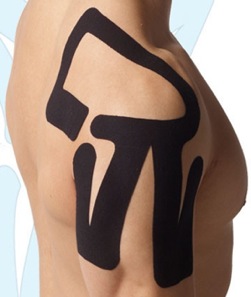IS KINESIOLOGY TAPE THE SECRET TO SUCCESS?
By Michael White
 You’ve probably seen brightly colored strips of fabric adorn the limbs of many a pro athlete in recent years. From motocross to cycling, swimming to basketball, athletes from a wide variety of sports have been seen competing with thick, colorful lines on their arms, legs and torsos. Those brightly colored lines and complex patterns aren’t the latest trend in body modification or adornment. They’re kinesiology tape.
You’ve probably seen brightly colored strips of fabric adorn the limbs of many a pro athlete in recent years. From motocross to cycling, swimming to basketball, athletes from a wide variety of sports have been seen competing with thick, colorful lines on their arms, legs and torsos. Those brightly colored lines and complex patterns aren’t the latest trend in body modification or adornment. They’re kinesiology tape.
WHAT IS KINESIOLOGY TAPE?
Available from a variety of manufacturers, kinesiology, or “kinesio,” tape is usually made of cotton fabric with an adhesive backing that is applied to the skin in such a way as to improve blood flow and help heal or protect injured muscles. “SpiderTech tape has been widely used in the medical and physical therapy fields during the company’s four-year history,” says SpiderTech’s sales and marketing coordinator Heather Price. Like other brands that offer kinesiology tape, SpiderTech sells rolls of its product in 5-meter lengths that can be cut and customized for a specific body part. “Our ?spiders’ are what sets SpiderTech apart from other tape brands,” says Price. “They’re precut designs that were developed in the physical therapy world that utilize a single piece of tape and have numbers printed on the back for a straightforward application. The product takes the guesswork out of kinesiology taping and empowers the consumer to do it right.” Bestsellers for the company include the upper-knee and lower-back varieties.
HOW DOES IT WORK?
“Kinesio tape is said to lift the skin, allowing for more lymph and blood flow,” says medical professional and motocross trainer Dr. Johnathan Edwards. SpiderTech, specifically, notes that their product “mimics the elasticity and thickness of human skin, allowing it to integrate, support and stabilize without adversely affecting healthy ranges of motion.” But can sticking material to the outermost layer of the skin really improve internal blood flow?
“Few of these claims have any scientific backing,” continues Edwards, “but numerous testimonials on the subject show athletes support its use. What seems to be clear from scientific literature is that taping modifies proprioceptive feedback?the information sent from muscles and tendons to the brain. Tape acts as a reminder of sorts that tells the brain to protect the injured area. Taping works psychologically through an increased awareness and perception of stability, leading to a decreased fear of activity and decreased pain.
“In my experience, taping cycling injuries can be a great tool when used properly, but avoid the temptation to just slap some kinesio tape on an injury. First, always get your injury diagnosed by a medical professional, because taping has the potential to make an injury worse. And note that many athletes wear the tape even if they don’t have an injury, usually as a preventive measure, for increased attention from the cameras and/or to fake out their opponents. In summary, there are not a lot of downsides, but much to gain if it helps.


“We used kinesiology tape with Zach Osborne several times during his 2012 racing season. Zach was battling a shoulder injury that still needed a little more recovery, but he had to race anyway. The shoulder was stable for the most part, but he needed a feeling of increased support and proprioception of his shoulder. For many of his Supercross races last year, I applied kinesiology tape to the pertinent areas of his shoulder with the goal of increasing the sensation when he moved his shoulder. Zach felt the tape helped as a reminder of what position his shoulder was in, especially through turns.”
STATS
Price: $6.99 (precut designs); $14.99 (5-meter roll)
Contact: www.spidertech.com




Comments are closed.